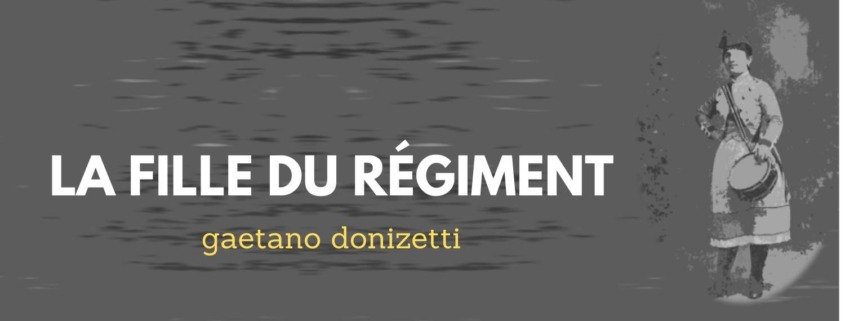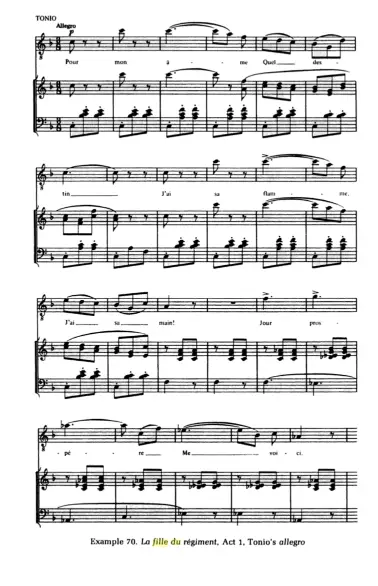POUR MON AME – an aria from La fille du regiment
The online guide to Gaetano Donizetti’s aria POUR MON AME
Read Interesting facts and hear great YouTube Videos about the famous Aria “POUR MON AME“.
The aria – synopsis and background
Synopsis: In an Austrian village in Tyrol during the Napoleonic Wars. The Marquise of Birkenfeld sought shelter there during her transit. In the passing French regiment lives Marie, who was adopted by the regiment as a little orphan girl at the time and now works as a sutler for the welfare of the soldiers. Sulpice, her foster father, speaks to Marie about a man with whom she has been seen frequently lately. She tells him that it is Tonio, a local who saved her life. Soldiers show up with a prisoner in their midst. Marie recognizes Tonio, who tried to see her and was caught. The soldiers threaten to kill the alleged spy. When they realize that Tonio is Marie’s lifesaver, they release him. When the two are alone, Tonio confesses his love to her. When Sulpice returns, he sends Tonio away and meets the Marquise. It turns out that Marie is the daughter of her sister with a deceased regimental captain Robert. So Marie is the Marquise’s niece. When Marie appears and Sulpice introduces her to her aunt she has to realize that Marie’s manners are not those of a fine lady. She wants to take Marie with her. When she resists, she takes out a letter from her deceased father, who declared this to be his last will. The soldiers appear. Among them is Tonio, who has registered to be close to Marie and wants to marry her. The soldiers are surprised to learn that the new soldier is the lover of the regiment’s daughter. Tonio asks her to marry him, because he is after all a soldier in the regiment.
“Pour mon ame” is the most famous piece of the opera “la fille du régiment” and one of the most famous tenor arias ever. It deserves this mainly because it requires the singer to sing an incredible 9 high C’s in only 2 minutes. The challenge of the aria lies in the fact that the high C’s must be sung with a robust chest tone and clear intonation (it should be noted that the high C was possibly sung only with the falsetto at the time of composition. The tenor Duprez sang it for the first time in Rossini’s William Tell in 1837 in chest, the so-called “do in petto”, and established the Voice Fach of the heroic tenor). Jokingly the aria is also called “the Mount Everest of tenors”. It is estimated that in one tenor generation there are only a handful of tenors who can sing them really perfectly. Pavarotti suddenly became famous with this aria in the United States (see below).
If the tenor is able to do this, the rest of the aria should not cause the singer any further major problems. Donizetti was gracious enough to place the rest of the tessitura in a singer-friendly area. There are no notes in the critical passenger area (around F). See an excerpt from the piano score:
Written for a tenore di grazia
The role of Tonio is written for a “tenore di grazia”. (Italian, literally: “tenor of (with) grace”) is an Italian opera term for a tenor type that lies between the tenor leggiero and the heavier tenor lirico. It is characterized above all by an elegant phrasing, mobility of the voice and a mostly warm (“sweet”) or very bright voice coloration. The genre originated in the great period of the romantic Belcanto style between ca. 1810-1850, in which this type of tenor was often assigned the roles of a youthful lover or hero (source: Wikipedia).
The Aria – the text of POUR MON AME
Pour mon âme, quel destin!
J’ai sa flamme,Et j’ai sa main!
Jour prospère!
Me voici Militaire, Militaire Et mari!
Militaire et mari!
Pour mon âme quel destin!
J’ai sa flamme, Et j’ai sa main!
J’en fais serment!
Pour mon âme, quel destin!
J’ai sa flamme, Et j’ai sa main!
Jour prospère!
Me voici Militaire.
What a prospect lies before me!
Her heart is mine and so is her hand!
O happy day!
Here I am, enlisted and engaged!
I am a soldier, I am a soldier,
I can claim her now!What a prospect lies before me!
Her heart is mine and so is her hand!
O happy day!
Here I am, enlisted and engaged!
I am a soldier, I am a soldier,
I can claim her now!
Famous interpretations of POUR MON AME
“La fille du regiment” from 1968 is one of the greatest recordings Pavarotti ever made. It was only his second complete recording of his then still young recording career. John Steane ( in “The grand tradition”), the influential critic speaks of one of the best tenor performances on record ever, sung with the finesse of the mature artist and the flourishing voice of the young man. The music journalist Edward Greenfield was present during the recording sessions and reported that this aria had to be sung several times before it was “in the can” and Pavarotti repeated and re-recorded this grueling act without slackening.
Pour mon ame – Pavarotti
Pavarotti’s MET performances in 1972 have become legendary. He took the audience by storm with his aria and with the following tour through the United States he finally became a tenorissimo on the American continent and the globe. He got the nickname “King of the High C’s”. We are listening to a recording of a Met performance from 1972
Pour mon ame – Pavarotti
Pavarotti was not a classical “tenore di grazia”, but usually sang in the somewhat “heavier” vocal fach of the “lyrical tenor”. The following recordings are from singers with slightly lighter voices, which are less strong and broad, but rise more gracefully into the upper notes.
Next we hear Alfredo Kraus, a spaniard and contemporary of Pavarotti. His singing skills were certainly on a par with those of his colleague, but he never reached his popularity. His technique was excellent and his height was excellent. His voice, however, did not have the warmth of the vibrato, but was more direct and straightforward. He could keep his voice until old age. We hear an excerpt that shows him in dazzling condition at the (for a tenor) respectable age of 59.
Pour mon ame – Kraus
Juan Diego Florez’s “Pour mon ame ” has a similar story of a famous encore. In 2007 he sang the Tonio at La Scala and he was the first to be granted an aria as an encore since 1933. Nota bene this was not allowed to a Tebaldi or Callas, nor to a Domingo or Pavarotti! We hear a live recording with an encore from from that time from the Genoa Opera House.
Pour mon ame – Florez
Next we hear Javier Camarena. Together with Juan Diego Florez he is the most outstanding Leggiero tenor of the first two decades of the 21st century. Camarena was also allowed to sing one of these absolutely rare encores at the Met. We hear him on this special occasion.
Pour mon ame – Camarena
For the American tenor Rockwell Blake, a great Rossini tenor, the 9 Cs were not enough, he regularly added 2 more.
Pour mon ame – Blake
In the second recording, accompanied by piano, Blake has expanded the ending, instead of ending with “militaire”, he sings “militaire et mari” with a high D!
Pour mon ame – Blake
A great recording is said to have been made by Leon Escalais at the beginning of the 20th century. Escalais was a French tenor whose greatest role was that of Arnoldo in Rossini’s William Tell. His “pour mon ame” is said to be a great reference recording of this aria by the frenchman, who took the high C’s with an incomparable brilliance. Unfortunately I could not find it on YouTube.
Peter Lutz, opera-inside, the online opera guide to the song “POUR MON AME” from the opera “La fille du régiment” from Gaetano Donizetti.





Leave a Reply
Want to join the discussion?Feel free to contribute!